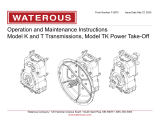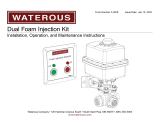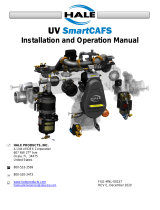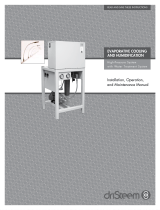Page is loading ...

FoamFill System
Installation and Operation
Form Number: F-2824 Issue Date: Mar 29, 2018
Waterous Company • 125 Hardman Avenue South • South Saint Paul, MN 55075 • (651) 450-5000
www.waterousco.com
FOAM FILL CONNECTION
Operating Instructions
Q-1230311
1. Connect fill hose assembly to quick connect port.
2. Press red POWER switch to activate system.
3. Press green AUTO switch for Auto Fill Mode.
Green LED will illuminate.
System will activate at low tank level.
Amber LED will flash until tank is filled.
4. Press yellow MANUAL switch for Manual Mode.
Amber LED will flash while filling.
System will operate until tank is full.
If MANUAL switch is held, system will operate until
switch is released.
5. Flush system when finished.
6. Refer to Waterous FoamFill Operation Manual for
detailed operating instructions.
FoamFill System
POWER
Q-1230310
AUTO FULL
POWER
AUTO MANUAL


Table of Contents
Safety 4
Safety Precautions 4
Introduction 5
Using this Document 5
Viewing the Document Electronically 5
Printing the Document 5
Product Overview 6
System Overview 6
Control Panel 7
Fill Pump 8
Quick-Connect Panel 9
Pick-Up Hose 9
Fill/Flush Valve 10
Instruction Plate 11
Additional Components 11
Installation 12
Installation Overview 12
Preparing for the Installation 12
Modifying the Equipment 12
Determining the Fill Pump Location 12
Determining the Panel, Plate, Valve, and Connection Locations 12
Determining Hose Routing 12
Determining Cable and Wire Routing 12
Hose Connections Overview 13
Electrical Connections Overview 14
Fill Pump Dimensions 15
Control Panel Dimensions 16
Fill/Flush Valve Dimensions 17
Instruction Plate Dimensions 18
Quick Connect Panel Dimensions 19
Installing the Fill Pump Assembly 20
Connecting Power to the Fill Pump 21
Installing the Control Panel 22
Installing the Fill/Flush Valve 23
Installing the Quick-Connect Panel 24
Installing the Instruction Plate 25
Installing the Tank-Level Sensors and Check Valve 26
Operation 28
Connecting the Pick-Up Hose 28
Operating in Manual-Fill Mode 29
Operating in Auto-Fill Mode 30
Automatic Shutoff 31
Flushing the Fill Pump 32
LED States 33
Service Parts 34
Main Components 34
Fill Pump Components 35
Control Panel and Wire Harness 36
Quick-Connect Panel Components 37
Pick-Up Hose Components 38
Fill/Flush Valve Components and Instruction Plate 39

Safety Introduction Product Overview Install ation Oper ation Service Parts
4 | 40
Safety Precautions
• Read and understand all the associated documentation before you begin the
installation.
• Read and understand all the notices and safety precautions.
• Be aware that these instructions are only guidelines and are not meant to be
denitive. Contact Waterous when you have questions about installing, or
operating, or maintaining the equipment.
• Do not install the equipment if you are not familiar with the tools and skills
needed to safely perform the required procedures—proper installation is the
responsibility of the purchaser.
• Do not operate the equipment when safety guards are removed.
• Do not modify the equipment.
• Regularly check for leaks, worn, or deteriorated parts.
NOTICE
Modifying the equipment
can damage components
and void your warranty.
•
Do not modify the system
or any of its components.
•
Modification
NOTICE
Before Operation
• Read and understand all
the instructions provided.
• Check all fluid levels
and replenish if necessary.
• Remove the all shipping
plugs and install the
operation plugs or caps.

5 | 40
Safety Introduction Product Overview Install ation Oper ation Service Parts
Use this document to install and operate your Waterous equipment. Understand
the following conditions before continuing with the document:
• The instructions may refer to options or equipment that you may not have
purchased with your system.
• The illustrations in this document are intended to convey concepts. Do not
use the illustrations to determine physical attributes, placement, or
proportion.
• Understand that your application may require additional steps, that are not
described in the illustrations or instructions, to perform the installation.
• Any equipment described in this document is intended to be installed by a
person or persons with the necessary skills and knowledge to perform the
installation.
• Any equipment described in this document is intended to be operated by a
person or persons with the basic knowledge of operating similar equipment.
This document is divided into the following sections:
Safety
This section describes general precautions and alert symbols that are in this
document.
Introduction
This section is an overview of the document.
Product Overview
This section describes the components that make-up the system.
Install ation
This section describes the installation and initial setup procedures.
Oper ation
This section describes the equipment operation.
Service Parts
This section describes the service parts.
Using this Document
Use the guidelines below when viewing this document.
Viewing the Document Electronically
• View this document in landscape orientation.
• Use the table of contents to navigate directly to that section.
• Text with this appearance is linked to a reference.
Printing the Document
• The document is viewed the best when printed in color.
• The print on both sides and features can provide the
best results.
• Use a 3-ring binder to store the document.

6 | 40
Safety Introduction Product Overview Install ation Oper ation Service Parts
System Overview
The foam-ll system enables you to ll the foam concentrate-supply tank from a foam concentrate-supply container. Included in this system is a pump and motor
assembly, control head, quick connect panel, overboard pick-up hose, ush valve assembly, tank-level sensors, wiring, check valve, and labels. Tank level
sensors communicate the concentrate level in the supply tank to the controller. The controller starts and stops the ll pump based on the tank-level sensors and
operating mode. The system operates in manual- or auto-ll mode. The system is available with a 3/4 or 1 inch pick-up hose, in brass or stainless steel, and 12 V
or 24 V.
Manual-Fill Mode Operation
Use the manual-ll mode to ll the tank. Press the manual button to start the ll
pump. The ll pump stops when the tank is full.
12
1. Start manual-ll mode whenever the supply tank is not full.
2. The ll pump stops when the supply tank is full.
Once the supply tank is full, the ll pump stops, and the cycle is completed. To
pump additional concentrate into the tank, press and hold the manual button to
run the ll pump. Do not overll the tank.
Auto-Fill Mode Operation
Use the auto-ll mode when on-scene. Press the auto button to enable auto-ll
mode. The ll pump starts when the tank level is low. The ll pump stops when
the tank is full. This cycle repeats until it is interrupted.
1 2
1. The ll pump starts when the concentrate level in the tank is low.
2. The ll pump stops when the tank is full.
The cycle repeats until the pump runtime expires, manual mode is enabled, or
the system is switched off.

7 | 40
Safety Introduction Product Overview Install ation Oper ation Service Parts
Control Panel
The control panel switches the system on or off, and enables or disables the system functions.
POWER
Q-1230310
AUTO FULL
POWER
AUTO MANUAL
5
4
2
3
1
6
7
Feature Description
1Mounting hole This secures the panel to the apparatus.
2Power button This switches the system on or off.
3Power LED This indicates when the system is on.
4Auto LED This indicates when the system is in auto-ll mode.
5Auto button This enables and disables auto-ll mode.
6 Full LED This indicates that the supply tank is full or the ll pump
is active.
7Manual button This enables you to manually operate the ll pump.
8
9
10
11
Feature Description
8Ground terminal This connects the tank sensors to ground.
9Tank-low terminal This connects the tank-low sensor to the controller.
10 Tank-full terminal This connects the tank-full sensor to the controller.
11 Wire-harness
connector
This connects the wire harness to the controller.

8 | 40
Safety Introduction Product Overview Install ation Oper ation Service Parts
Fill Pump
The ll pump transfers the foam concentrate from the supply container to the supply tank.
3
4
1
2
5
6
Feature Description
1Cover This protects the internal components.
2 Fill pump connector This connects ll pump to the control panel.
3Cover nut This secures the cover to the assembly.
4 Base mount This secures the ll pump to the apparatus.
5Discharge port This is the ll pump discharge.
6Inlet port This is the ll pump inlet.

9 | 40
Safety Introduction Product Overview Install ation Oper ation Service Parts
Quick-Connect Panel
The quick-connect panel connects the pick-up hose to the ll pump. It is
available in brass or stainless steel and for a 3/4 or 1 inch.
FOAMFILL CONNECTION
2
3
1
Feature Description
1Mounting hole This secures the panel to the apparatus.
2Panel-quick connect This couples to the pick-up hose.
3 Quick-connect cap This protects the connector when not in use.
Pick-Up Hose
The pick-up hose transfers concentrate from the supply container to the
system. It is available in brass or stainless steel and 3/4 or 1 inch.
4
6
5
7
Feature Description
4 Quick-connect cap This protects the connector when not in use.
5Hose-quick connect This couples the pick-up hose to the system.
6Hose This is the hose and is available in 2 lengths:
• For bucket style container—6 ft (2 m) included.
• For drum style container—10 ft (3 m) available.
7Wand This is inserted into the supply container.

10 | 40
Safety Introduction Product Overview Install ation Oper ation Service Parts
Fill/Flush Valve
The ll/ush valve directs concentrate to the supply tank or water to the ush hose.
2
1
Feature Description
1Mounting hole This secures the panel to the apparatus.
2Valve handle This operates the valve.
3
4
5
Feature Description
3Valve inlet port This connects to the ll pump discharge port.
4 Fill output port This connects to the concentrate-supply tank.
5 Flush output port This connects to the ush hose.

11 | 40
Safety Introduction Product Overview Install ation Oper ation Service Parts
Instruction Plate
The instruction plate describes how to operate the system.
Operating Instructions
Q-1230311
1. Connect fill hose assembly to quick connect port.
2. Press red POWER switch to activate system.
3. Press green AUTO switch for Auto Fill Mode.
Green LED will illuminate.
System will activate at low tank level.
Amber LED will flash until tank is filled.
4. Press yellow MANUAL switch for Manual Mode.
Amber LED will flash while filling.
System will operate until tank is full.
If MANUAL switch is held, system will operate until
switch is released.
5. Flush system when finished.
6. Refer to Waterous FoamFill Operation Manual for
detailed operating instructions.
FoamFill System
2
1
Feature Description
1Mounting holes These secures the panel to the apparatus.
2Instruction label This plate instructs how to use the system.
Additional Components
The remaining components support system operation and control.
5
3
4
Feature Description
3 Tank-level sensor This senses the concentrate level in the supply tank.
The system includes 2 sensors, 1 for tank full and 1
for tank low.
4Check valve This prevents concentrate from reversing the ow
direction.
5Wire harness This connects the control panel and ll pump.

12 | 40
Safety Introduction Product Overview Install ation Oper ation Service Parts
Installation Overview
This equipment is intended to be installed by a person or persons with the basic
knowledge of installing similar equipment. Contact Waterous with questions
about installing the equipment. The installation may require the following tasks
and abilities:
• Locating, drilling, and cutting
features into the apparatus.
• Connecting the hoses and ttings.
• Routing and securing the hoses.
• Routing and securing the wiring.
• Programming and nal testing.
Preparing for the Installation
Read and understand all the installation instructions before installing the
equipment. Prepare a suitable, well-lit area, and gather all the necessary tools
before you begin the installation.
Modifying the Equipment
This equipment is intended to operate as designed. Do not remove, modify, or
change the components in the system. Doing so will void the warranty. Contact
Waterous for more information.
NOTICE
Modifying the equipment
can damage components
and void your warranty.
•
Do not modify the system
or any of its components.
•
Modification
Do not modify the system or any components. Doing so will void your
warranty.
Determining the Fill Pump Location
Use the following guidelines to determine a location to mount the ll pump:
• Consider the hose and cable routing.
• Consider accessibility for maintenance.
• Mount the ll pump where it has minimal exposure to excessive dirt, road
debris, and heat buildup.
• Mount the ll pump in a location and orientation that enables you to drain the
system during freezing temperatures.
Determining the Panel, Plate, Valve, and Connection
Locations
Use the following guidelines to determine a location to mount the control panel,
instruction panel, plate, ush valve, and quick-connect panel location:
• Consider the wire harness and hose routing.
• Consider accessibility during operation and maintenance.
• Install instruction plates near their applicable operator panels.
Determining Hose Routing
Use the following guidelines when routing the hoses:
• Route the hose in a straight line whenever possible.
• Do not pinch or kink the hose.
• Do not secure the hose to moving parts.
• Do not secure the hose near excessive heat.
Determining Cable and Wire Routing
Use the document, available at www.waterousco.com, as
a guide to select and route wiring for your application.

13 | 40
Safety Introduction Product Overview Install ation Oper ation Service Parts
Hose Connections Overview
12 3 4 5 76
8 9 10
Use the illustration to identify the hose connections
between the components.
1Pick-up hose
2Quick-connect panel
3Quick connect to ll pump hose
4Fill pump
5Fill pump to ll/ush-valve hose
6Fill/ush valve
7Concentrate-supply tank
8 Flush hose
9Fill/ush valve to supply-tank hose
10 Check valve

14 | 40
Safety Introduction Product Overview Install ation Oper ation Service Parts
Electrical Connections Overview
10
1 2
9111213
3
4
8
5
7
6
14
15
16
Use the illustration to identify the electrical
connections between the components.
1 Fill pump to wire-harness connector
2Wire harness to ll pump connector
3 Tank-full sensor—shown in the
position.
4 Tank-low sensor—shown in the position.
5 Tank-full sensor terminal
6Tank-low sensor terminal
7 Tank-full and tank-low sensor ground terminal
8 Control panel to wire-harness connector
9 Wire harness to control-panel connector
The following items are installer supplied.
10 Ground wire (–)
11 Power supply
12 Power wire (+)
13 Circuit breaker—determined from all the
devices in the circuit.
Fill pump current draw:
• 12 V ll pump—30 A
• 24 V ll pump—15 A
14 Positive (+) wire
15 Solenoid positive (+) post
16 Ground (–) post

15 | 40
Safety Introduction Product Overview Install ation Oper ation Service Parts
Fill Pump Dimensions
1.297in
32.94mm
2X
5.000in
127mm
2.037in
51.74mm
1.161in
29.48mm
2.037in
51.74mm
0.220in
5.59mm
9.226in
234.35mm
2X
7.500in
190.50mm
2X
0.375in
9.53mm
8.250in
209.55mm
2.205in
56.02mm
INLET 3/4
NPT (F)
OUTLET
3/4 NPT (F)
4X R
5.20in
132.03mm
1.142in
29mm
2X
0.125in
3.18mm
IL4580

16 | 40
Safety Introduction Product Overview Install ation Oper ation Service Parts
Control Panel Dimensions
4.000in
101.60mm
4.000in
101.60mm
2X
3.500in
88.90mm
2X
3.500in
88.90mm
4X
0.201in
5.11mm
1.819in
46.21mm
0.130in
3.30mm
2X
3.500in
88.90mm
2X
3.500in
88.90mm
3.250in
82.55mm
3.250in
82.55mm
4X
0.201in
5.11mm
2X
0.125in
3.18mm
2X
0.125in
3.18mm
4X
R0.125in
3.18mm
PANEL CUT-OUT
IL4581
POWER
Q-1230310
AUTO FULL
POWER
AUTO MANUAL

17 | 40
Safety Introduction Product Overview Install ation Oper ation Service Parts
Fill/Flush Valve Dimensions
5.500in
139.70mm
5.500in
139.70mm
5.000in
127mm
5.000in
127mm
4X
0.201in
5.11mm
1.643in
41.73mm
0.849in
21.56mm
1.866in
47.40mm
0.125in
3.18mm
3X 3/4 NPT (F)
IL4584
4X
0.201in
5.11mm
4.000in
101.60mm
4.000in
101.60mm
4X
R0.250in
6.35mm
2X
5.000in
127mm
2X
5.000in
127mm
2X
0.500in
12.70mm
2X
0.500in
12.70mm
PANEL CUT-OUT

18 | 40
Safety Introduction Product Overview Install ation Oper ation Service Parts
Instruction Plate Dimensions
4.250in
107.95mm
4.250in
107.95mm
2X
3.750in
95.25mm
2X
3.750in
95.25mm
4X
0.201in
5.11mm
IL4586
Operating Instructions
Q-1230311
1. Connect fill hose assembly to quick connect port.
2. Press red POWER switch to activate system.
3. Press green AUTO switch for Auto Fill Mode.
Green LED will illuminate.
System will activate at low tank level.
Amber LED will flash until tank is filled.
4. Press yellow MANUAL switch for Manual Mode.
Amber LED will flash while filling.
System will operate until tank is full.
If MANUAL switch is held, system will operate until
switch is released.
5. Flush system when finished.
6. Refer to Waterous FoamFill Operation Manual for
detailed operating instructions.
FoamFill System

19 | 40
Safety Introduction Product Overview Install ation Oper ation Service Parts
Quick Connect Panel Dimensions
0.125in
3.18mm
3.250in
82.55mm
2.940in
74.68mm
0.660in
16.76mm
2X
3.500in
88.90mm
4X
R0.375in
9.53mm
4X
0.201in
5.11mm
4.000in
101.60mm
4.000in
101.60mm
2X
3.500in
88.90mm
2X
3.500in
88.90mm
4X
0.201in
5.11mm
2.025in
51.44mm
0.125in
3.18mm
1.570in
39.88mm
2.220
1 IN. QUICK CONNECT PANEL SUBASSY
2.195in
55.75mm
2.150in
54.61mm
2.600
PANEL CUT-OUT
FITS BOTH SIZES
IL4585
3/4 IN. QUICK CONNECT PANEL SUBASSY
DIMENSIONS SHOW DIFFERENCE FROM 3/4 IN.
3/4in NPT (F)
1in NPT (F)

20 | 40
Safety Introduction Product Overview Install ation Oper ation Service Parts
Installing the Fill Pump Assembly
1
2
3
5
4
Use the illustrations and instructions to install the
ll pump to the apparatus. Refer to: "Determining
the Fill Pump Location" on page 12
1 Locate and drill the mounting holes. Refer to:
"Fill Pump Dimensions" on page 15
2 Use locally sourced hardware to secure the
component to the apparatus.
3 Fill pump assembly
4 Connect the wire-harness connector to the
ll-pump connector.
5Fill-pump connector
/












